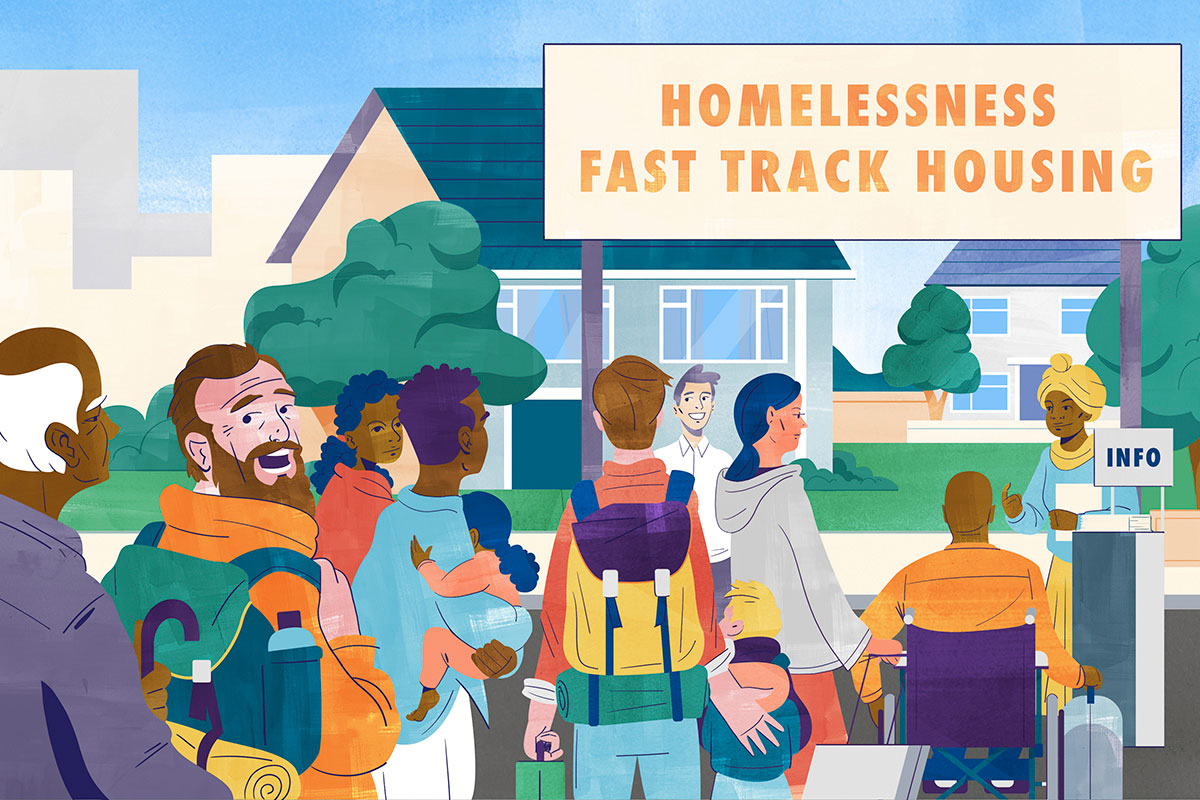You are viewing 1 of your 1 free articles
How rapid rehousing is preventing homeless people being stuck in temporary accommodation
Scotland and Wales have implemented a policy called ‘rapid rehousing’, with the aim of cutting the amount of time homeless people are stuck in temporary accommodation. Eve Livingston investigates. Illustration by Jamie Wignall
Stuart Dale never expected to become homeless. Before the COVID-19 pandemic, he enjoyed a successful career in TV production and lived in Glasgow’s affluent West End with his partner. A former alcoholic, he had taken up swimming and volunteering at a local cinema as part of his recovery. But in the space of a few months, the relationship ended, the pandemic caused his work to dry up, and lockdown stopped his hobbies overnight. Mr Dale, now 46, found himself travelling around the UK in search of work and a sofa to sleep on.
It could easily have been the start of a downward spiral for Mr Dale, who felt his mental health deteriorate amid the uncertainty of the pandemic. Upon his return to Glasgow, he found himself in a city centre hotel often used to house prison-leavers. “There were blood spatters on the wall, needles everywhere, a lot of people with drink problems,” he recalls.
For a week, he was too scared to leave his room. But when he did, he walked past a sign offering help with homelessness in the window of Wheatley’s offices. A month later, he signed a lease with Glasgow Housing Association (a subsidiary of 61,000-home Wheatley) for a permanent home in Drumchapel, north-west Glasgow.
Mr Dale’s experience speaks to the relative success Scotland has had in adopting a rapid rehousing agenda since around 2018, as a result of recommendations made in the Ending Homelessness Together Action Plan published that year. Referring to a range of policies, programmes and processes designed to get people into and out of the homelessness system as quickly as possible, rapid rehousing describes the standard response to anyone who becomes homeless in Scotland, regardless of circumstance.
“It’s really about saying homelessness doesn’t necessitate a large-scale industry of special provision or temporary accommodation,” says Dr Beth Watts, senior research fellow at the Institute for Social Policy, Housing and Equalities Research (I-SPHERE) at Heriot-Watt University. “People experiencing homelessness want ordinary mainstream homes like the rest of us and by getting them into housing and giving support where it’s needed, experiences of homelessness can be brief and minimally damaging.”
Tailored support
In Scotland, the rapid rehousing agenda has its origins in the expansion of legal entitlements to housing made in 2012. That year, the Scottish government extended legal rights to settled housing to virtually all individuals facing homelessness, a move praised as an example of strong moral leadership on homelessness.
“By getting [people] into housing and giving support where it’s needed, experiences of homelessness can be brief and minimally damaging”
But the policy caused a rapid and significant increase in the use of temporary accommodation, which has continued today. Rapid rehousing, Dr Watts says, “is an attempt to keep those strong legal entitlements while also trying to address those unintended negative consequences, recognising that spending months or years in the limbo of temporary accommodation is unacceptable”.
There were 13,097 households in temporary accommodation in Scotland as of March, according to the most recent statistics available. This is 12% more than the previous year.
According to Maggie Brünjes, chief executive of Homeless Network Scotland, around 50% of those who present as homeless to their local authority in Scotland will require no further support beyond housing. The other half are made up of people or families with other health and social care needs such as addictions, poor mental health or experiences of trauma. Of these, around 10% will have particularly acute support needs.
Ms Brünjes says: “What happened traditionally is that they were all treated the same, which created a slow, creaking system that people spent too long in.”
Those who only need a home are supported to access one, while others are also signposted to support services. Those with the most complex needs are directed to programmes such as Housing First, which sees them supported into a permanent home and provided with wraparound support.
Strong start
In Mr Dale’s case, recovery from alcoholism made him eligible for Glasgow’s Housing First programme and he was quickly moved to a Salvation Army hostel, where Wheatley provided drop-in support, and then to his own flat. He was able to view a number of properties, with no obligation to take up a tenancy in any, and signed a permanent lease at social rent. When it came to applying for benefits, a support worker visited his flat and went through the paperwork with him. When his cooker needed repairs, he was provided with supermarket vouchers for microwaveable meals. And when he experienced tensions with his family, his Housing First contact was available to listen.
While championed and funded at government level, rapid rehousing is the responsibility of Scotland’s local authorities, each of which has been required to have in place a rapid rehousing transition plan since 2019. “We’re at the very beginning of this but we’ve made a really strong start,” Ms Brünjes says. “We have 32 local authorities in Scotland who are all on board with this.”
The picture varies across these 32 local authorities, but there are already success stories among them. As an early adopter of the agenda, Perth & Kinross Council managed to bring its temporary accommodation numbers down prior to the pandemic and is now, in some cases, able to resettle those with low or no support needs within a day.
As of October this year, the council had cut its housing backlog from 537 homeless households awaiting a permanent home to 31.
And in Dundee, where the city council is an original partner for a Housing First pilot in Scotland, the programme has now been mainstreamed and brought in house. While the pandemic has affected timescales on rapid rehousing, David Simpson, its head of housing and communities, says: “Our goals remain to end the need for rough sleeping; prevent homelessness where this is possible; continue to offer Housing First where this is the best option for the applicant; reduce the level of temporary accommodation; and speed up the length of time taken to secure a permanent outcome for homeless persons.”
The Scottish government committed £24m over three years to rapid rehousing. Dundee Council converted temporary furnished flats into permanent tenancies where possible, but market pressures in other areas have made this work more challenging.
“By getting [people] into housing and giving support where it’s needed, experiences of homelessness can be brief and minimally damaging”
Rapid rehousing has also been embraced in Wales, where it was central to recommendations made by the government’s Homelessness Action Group before the pandemic. But while the COVID-19 response has increased the impetus for change, it has also added to the challenges in making it happen. “[Rapid rehousing] is something everybody is working towards, though we’re coming from a different starting place to Scotland because of the opening up of entitlements during the pandemic,” says Jennie Bibbings, head of campaigns at Shelter Cymru.
In an echo of Scotland’s historic experience, priority-needs testing has been suspended in Wales as a result of the pandemic response but consequently the numbers of people in temporary accommodation – and on waiting lists to access it – remain higher than ever.
As of September 2021, 6,935 people in Wales were in temporary accommodation, compared to around 2,000 before the pandemic.
“It’s so hard to be strategic when you’re constantly firefighting,” says Ms Bibbings. “That’s where the Welsh government can help – with strong commitment, funding to get the right homes in place and support with planning, they can help local authorities be more joined-up around this agenda.”
At the end of November, climate change and housing minister Julie James reaffirmed the Welsh government’s commitment to rapid rehousing when she launched the Ending Homelessness Action Plan and announced £30m of funding for local authorities. “My priority now is to build on our successes to prevent homelessness and ensure that when it does [occur], it is rare, brief and unrepeated,” Ms James said.
In Scotland, the future of the rapid rehousing agenda relies on continued support and funding from the Scottish government, including that required to address the progress that was interrupted by the pandemic.
Ms Brünjes notes that the areas predicted to be most successful with rapid rehousing have in common rapid rehousing quotas where a certain proportion of social housing lets are reserved for homeless households. “Rapid rehousing does depend on an adequate supply of social housing,” she says.
In his flat in Drumchapel, Mr Dale is optimistic. He is beginning to secure more work, but he has also been supported through Housing First to access benefits in the meantime.
“I did end up in a scary situation very quickly, but then I got moved through it very quickly, too,” he says. “Now I’m in this absolutely lovely flat with the train station down the road, my parents nearby and the swimming pool 500 yards away.”
Sign up for our Scotland newsletter
Already have an account? Click here to manage your newsletters
Sign up for our Wales newsletter
New to Inside Housing? Click here to register and receive our Wales round-up straight to your inbox
Already have an account? Click here to manage your newsletters













